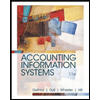3-52 LO 5 Authorization of transactions is considered a key control in most organizations. Authorizations should not be made by individuals who have incompatible functions. For each transaction (listed as A. through I. below), indicate the individual or function (e.g., the head of a particular department) that should have the ability to authorize that transaction. Briefly provide rationale for your answer. A. Writing off old accounts receivable. B. Committing the organization to acquire another company that is half the size of the existing company. C. Paying an employee for overtime. D. Shipping goods on account to a new customer. E. Purchasing goods from a new vendor. F. Temporarily investing funds in common stock investments instead of money market funds. G. Purchasing a new line of manufacturing equipment to remodel a production line at one of the company’s major divisions (the purchase represents a major new investment for the organization). H. Replacing an older machine at one of the company’s major divisions. I. Rewriting the company’s major computer program for processing purchase orders and accounts payable (the cost of rewriting the program will represent one quarter of the organization’s computer development budget for the year).
3-52 LO 5 Authorization of transactions is considered a key control in
most organizations. Authorizations should not be made by individuals
who have incompatible functions. For each transaction (listed
as A. through I. below), indicate the individual or function (e.g., the
head of a particular department) that should have the ability to
authorize that transaction. Briefly provide rationale for your answer.
A. Writing off old accounts receivable.
B. Committing the organization to acquire another company that
is half the size of the existing company.
C. Paying an employee for overtime.
D. Shipping goods on account to a new customer.
E. Purchasing goods from a new vendor.
F. Temporarily investing funds in common stock investments
instead of
G. Purchasing a new line of manufacturing equipment to remodel a
production line at one of the company’s major divisions (the
purchase represents a major new investment for the
organization).
H. Replacing an older machine at one of the company’s major
divisions.
I. Rewriting the company’s major computer program for processing
purchase orders and accounts payable (the cost of rewriting
the program will represent one quarter of the organization’s
computer development budget for the year).
3-70 LO 8 The following scenario describes PPC, a small plastics producer
with $250 million in revenue and approximately 300
employees. PPC is a public company that first became listed three
years ago. It has been hit hard by the recent recession, and its sales
have dropped from $1,375 million to $1,250 million. It is barely
profitable and is just meeting some of its most important debt covenants.
During the past year, John Slade, CEO and owner of 22% of
the company’s shares, has taken the following actions (listed as A.
through I. below) to reduce costs. For each action, complete the
following.
a. Would the action be considered an operational issue and not a
control deficiency, or would it likely constitute a material
weakness or significant deficiency in internal control? Provide
brief rationale for your assessment. If additional information
is needed in order to assess whether the item is a control
deficiency, briefly indicate what information would be
required.
b. Considering all of the indicated actions (A. through I. below),
how has the risk related to the objective of reliable financial
reporting changed during the year?
A. Laid off approximately 75 factory workers and streamlined
receiving and shipping to be more efficient.
B. Cut hourly wages by $3 per hour.
C. Reduced the size of the board by eliminating three of the
four independent directors and changed the compensation
of remaining board members to 100% stock options to
save
remaining six directors with a market value of $100,000
per director, but no cash outlay.
D. Eliminated the internal audit department at a savings of
$450,000. The process owners (e.g., those responsible for
accounts payable) are now required to objectively evaluate
the quality of controls over their own areas and thus to
serve as a basis for management’s report on the effectiveness
of internal control.
E. Changed from a Big 4 audit firm to a regional audit firm,
resulting in an additional audit savings of $300,000. This is
the first public company audit for the new firm.
F. Because internal audit no longer exists, the CEO relies on
monitoring as the major form of control assessment. Most
of the monitoring consists of comparing budget with actual
results. Management argues this is very effective because
the CEO is very much involved in operations and would
know if there is a reporting problem.
G. Set tight performance goals for managers and promised a
bonus of 20% of their salary if they meet the performance
objectives. The performance objectives relate to increased
profitability and meeting existing volumes.
H. The purchasing department has been challenged to move
away from single-supplier contracts to identify suppliers
that can significantly reduce the cost of products purchased.
I. Put a freeze on all hiring, in spite of the fact that the
accounting department has lost its assistant controller. This
has required a great deal of extra overtime for most
accounting personnel, who are quite stressed.
Trending now
This is a popular solution!
Step by step
Solved in 2 steps






